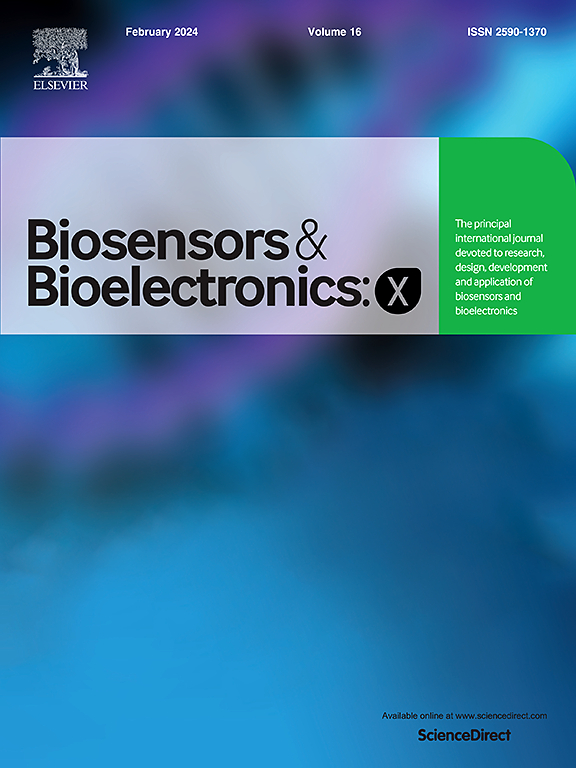用于葡萄糖非酶定量的被动实验室- pcb微系统
IF 10.61
Q3 Biochemistry, Genetics and Molecular Biology
引用次数: 0
摘要
本文介绍并成功演示了一种用于葡萄糖定量的新型无源印刷电路板实验室(PCB)诊断平台,用于无泵应用,如可穿戴诊断贴片。该平台利用氧化铜纳米颗粒进行非酶、电化学葡萄糖定量,实现了汗液或组织液样品分析所必需的高灵敏度和线性操作范围。结果表明,该平台具有2.1 μM的低检出限和456 μA mM−1·cm−2的高灵敏度,并且对常见的葡萄糖干扰物质具有良好的特异性。首先概述了无源微流体与电化学葡萄糖生物传感器的无缝集成,并在可扩展的葡萄糖定量平台上使用标准光刻技术制作。在两种样品流动条件下对葡萄糖的检测进行了详细的研究,包括静态和动态条件,揭示了当受到连续流动的影响时,微系统表现出灵敏度的增加和线性范围的减小。这项工作表明,我们新的无源印刷电路板实验室(PCB)诊断平台可以在连续样品流条件下成功实施,因此非常适合可穿戴诊断贴片应用。此外,测量的性能超过了迄今为止报道的静态流方法,包括基于纸张的方法。本文章由计算机程序翻译,如有差异,请以英文原文为准。

A passive Lab-on-PCB microsystem for non-enzymatic quantification of glucose
This paper presents and successfully demonstrates a new form of passive Lab-on-printed circuit board (PCB) diagnostic platform for the quantification of glucose, as required for pumpless applications such as wearable diagnostic patches. The platform exploits copper oxide (CuO) nanoparticles for non-enzymatic, electrochemical glucose quantification, to achieve the high sensitivity and linear range of operation that is necessary for sweat or interstitial fluid sample analysis. As a result, the platform exhibits a low limit of detection (LoD) of 2.1 μM and a high sensitivity of 456 μA mM−1·cm−2, coupled with an excellent specificity against common glucose interfering species. The seamless integration of passive microfluidics and an electrochemical glucose biosensor is firstly outlined, and is fabricated using standard photolithography techniques in an up-scalable glucose quantification platform. The detection of glucose under two sample flow conditions is investigated in detail, including both static and dynamic conditions, revealing that when subject to a continuous flow the microsystem demonstrates an increase in sensitivity and a reduced linear range. This work demonstrates that our new passive Lab-on-printed circuit board (PCB) diagnostic platform can be successfully implemented under continuous sample flow conditions, and is therefore ideally suited to wearable diagnostic patch applications. In addition, the measured performance exceeds static flow approaches that have reported to date, including paper-based approaches.
求助全文
通过发布文献求助,成功后即可免费获取论文全文。
去求助
来源期刊

Biosensors and Bioelectronics: X
Biochemistry, Genetics and Molecular Biology-Biophysics
CiteScore
4.60
自引率
0.00%
发文量
166
审稿时长
54 days
期刊介绍:
Biosensors and Bioelectronics: X, an open-access companion journal of Biosensors and Bioelectronics, boasts a 2020 Impact Factor of 10.61 (Journal Citation Reports, Clarivate Analytics 2021). Offering authors the opportunity to share their innovative work freely and globally, Biosensors and Bioelectronics: X aims to be a timely and permanent source of information. The journal publishes original research papers, review articles, communications, editorial highlights, perspectives, opinions, and commentaries at the intersection of technological advancements and high-impact applications. Manuscripts submitted to Biosensors and Bioelectronics: X are assessed based on originality and innovation in technology development or applications, aligning with the journal's goal to cater to a broad audience interested in this dynamic field.
 求助内容:
求助内容: 应助结果提醒方式:
应助结果提醒方式:


